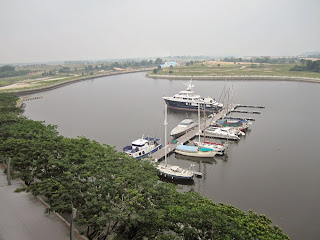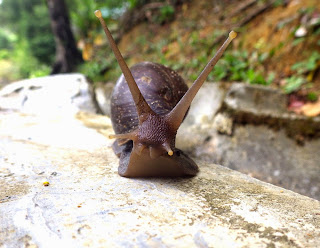Singapore to Phuket
Our new Crew, David and Noreen quickly fit into Silver
Tern’s mode. David is a retired biologist, Noreen a retired physician and both
are avid birders and good natural historians. We spent a couple of days at the
dock in Puteri harbour, marina getting ready for our trip from Singapore up to
Thailand. A number of the pictures in this blog were taken by either David or
Noreen, thanks!
Puteri Harbor with Silver Tern about half-way up the right side of the dock.
While working around the boat I noticed a small (1”) crab
that appeared to be swimming on its back on the surface of the water, then I
noticed another doing the same thing. On closer inspection, there were lots of
them, and they were using leaves as floats, grabbing onto them with their
hindmost legs and using the next set of legs to “row” themselves around,usually
upside down. I had never heard of this behavior, nor have my invertebrate
biologist friends, so I wonder if crabs making boats is another example of
“tool use” among animals. If their leaf was taken away and another floating object
(cardboard, wood etc.) offered, the crab would quickly grab onto and make off
with their new “boat”.
Leaving Puteri harbor we had to go under the same two
bridges that we passed on the way in. They were still intimidating. While they
were supposed to be 25 meters tall and our mast is only 23 meters, looking up
it appeared like we were way too close. In any case, there was enough clearance
and we left Puteri and headed up the Malacca Straits.
Still lots of freighter
traffic, but nothing like we encountered entering Singapore.
The Straits of Malacca are rich with the history of trading
and colonial ventures. In the town of Malacca we took a ride on a canal boat
that took us through parts of town that seemed like an amalgamation of Venice,
Italy and Buenos Aires, Argentina.
There were a huge number of museums from colonial history to
maritime to a kite museum.
This is also a very heavily fished area. Fishing ranged from
individuals with cast nets
To trollers, to draggers, to seiners, even pair trawlers.
In addition, everywhere there were floats, some supporting
surface gill nets but most just marking fish traps. The floats ranged from
quite substantial to a pair of soda bottles with a piece of bamboo with a rag
on top. The only danger these posed was running directly over them and tangling
the line in our propellers. The other problem is that the traps were home-made
from bamboo and old gill net material. As they get old they are abandoned and
end up floating around just at the surface. A structure of bamboo and netting
would also easily catch a propeller.
What all of this meant is that a constant watch was
essential. Both David and Noreen became expert at spotting fishermen, flags,
floats and traps.
The trip north included stops at several marinas, in one of
which we met our friends Fred and Christianne from the Nordhaven 46 Arcturus.
They have taken Arcturus from Dana Point, California all the way to SE Asia and
have cruised her extensively for the past 15 years. We had a great visit and
dinner with them before heading on north.
When we could, we went ashore and took hikes, often running
into local inhabitants.
and enjoying the offerings of the local markets
Approaching Thailand we anchored up a river Sungai Selangor)
where we explored the mangroves and watched the fishermen and birds as the
evening set in.
A bit north, Noreen said we should watch out for milky
storks, a rare bird sometimes found in the area. As I had just taken a photo of
a stork flying by I showed it to her, and we actually have an OK if not great photo of the rare milky stork
Anchored at Pulau Bidan, three of us went ashore while Pat
stayed on the boat and made dinner.
Like many other deserted beaches in SE Asia and around the world, this one was
full of litter, mostly plastic trash. Among the trash of course were beautiful
sea shells and animal tracks.
We also found ruins
that appeared to be from WW II. And David and I saw a monitor lizard that was
easily 6’ long and must have weighed well over 100.bs. Back on the boat we were abbe to watch a Brahminy Kite fishing nearby.
However, the real king of the skies is the white bellied sea
eagle
The sea eagle started to chase the kite off, but the tables
were quickly turned when the kite’s mate appeared and the two of them chased
off the intruding sea eagle.
The northernmost set of islands in Malaysia are around
Lankawi and we enjoyed several days exploring this area. Beautiful islands,
great wildlife and protected anchorages. However, the water was too murky for snorkeling
so we decided to continue on into Thailand
North of Lankawi we were in Thai waters. For reasons we
don’t understand, the waters are clearer here. We took a week to cruise the
islands here, sailing for a few hours and then anchoring at interesting
islands. The first anchorage was at Ko Tarutao where we took several dinghy
rides up a pristine mangrove estuary.
We were lucky to spot
a variety of birds and monkeys including more hornbills and spectacled langurs.
This mother was carrying a very young infant, but it did not
seem to slow her down much
Most of these islands are limestone (karst) and in the
middle of the mangrove swamp we found some really interesting limestone cliffs
and formations
Leaving Tarutao Island we tried David’s fishing rig and caught a
military seapike (a small relative the barracuda). Very nice dinner.
As we traveled on we had to avoid lots of low-tech FADs
(fish attracting devices). Again, lots of eyes watching as most were not as
easy to spot as this one was, sometimes just a single small bamboo a couple of
feet above the surface.
Our next stop was at Ko Rok Nok where we were able to tie to
a park mooring and do some marvelous snorkeling. The water was clear, the coral
was in good shape and there was the incredible diversity of animals you would
expect in the tropics.
This sea snake wandered through the reef, completely unperturbed by us. Notice how similar the head is to the tail! Which is which?This anemonefish was not in any of our books but was quite common. The anemones that it lives in are quite beautiful as well as unique.
Black-spotted Puffers were common and usually completely oblivious to our presence.
I never get over the patterns and colors on a coral reef. This giant clam (Tridacna) has colors that beautifully match its surrounding coral
While this individual has a suite of simply outlandish colors and patterns.
Sea Cucumbers are the bottom cleaners of the reef, removing organic materials from the sand.
The dusky wrasse is one of those pickers who looks for small animals among the corals.
Golden and Java rabbitfish were both common on the reefs

 |
| Christmas tree worms come in a variety of colors but are incredibly intricate plankton feeders |
Bicolor blennies are simply too cute to ignore, this one was feeding on its small algae patch.
The powderblue surgeonfish (yes, that is its real name) was another striking reef inhabitant.
After that we cruised to Ko Muk, the home of the well known
“Emerald Cave”. We were able to visit it first thing in the morning before the
tour boats arrived. It involved a 100 yard swim into a dark cave, but near the
end was a side channel that led out to an enclosed beach open to the sky from a
past collapse. You could walk 20 ft back into tropical trees before the rocks
led straight up 250 ft. to the top. When you swim towards either entrance, looking
underwater, the color is an emerald green.
The anchorage here was big enough for only one boat and it
was the most picturesque anchorage yet, so a photo was in order.
The tall, karst
islands of Thailand are stunningly beautiful and many are home to countless numbers of of
swiftlets and bats.
We checked into Thailand in Ao Chalog, the main yacht harbor
in Phuket at their one stop building for customs immigration and port captain-
Very efficient.
We had dinner at the Yacht Club with our friend Bob Mott and had a quiet night anchored in the harbor.
The next we headed the next day to our
destination, Yacht Haven Marina. Nice marina, but pretty isolated. Once again,
our solar array has proven invaluable. We have not needed any external power since we
launched Silver Tern.
Going to a movie in Phuket was an interesting experience.
You choose your seats when you buy your
tickets and they are very comfortable with high backs. But before the movie starts, after the upcoming movie trailers, everyone stands and listens to the King’s
anthem. The fact that we had to sit
through the Avengers was incidental; the theater was air conditioned and the sound and picture quality were stunning . Outside was 98 degrees with 90% humidity.
We are now getting Silver Tern ready for her six-month layup on the hard here in Northern Phuket.
SILVER TERN IS FOR SALE
Sadly enough, we have decided to sell Silver Tern. Having two boats in different hemispheres is just too much for us and we feel the need to be closer to friends and family. So, as of right now, Silver Tern is for sale for $325,000.00 US dollars. That is almost exactly what it cost to build her, not counting our labor, so she will be a great buy for someone. She will soon be listed with a broker, but you can purchase her directly from us if you wish. email: steveandpatstrand@gmail.com

























































No comments:
Post a Comment